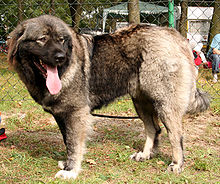Caucasian Shepherd Dog
| Caucasian Shepherd Dog | |||||||||||||||||||||||||||||
|---|---|---|---|---|---|---|---|---|---|---|---|---|---|---|---|---|---|---|---|---|---|---|---|---|---|---|---|---|---|
 | |||||||||||||||||||||||||||||
| Other names |
|
||||||||||||||||||||||||||||
| Origin | Georgia | ||||||||||||||||||||||||||||
| |||||||||||||||||||||||||||||
| |||||||||||||||||||||||||||||
| Dog (domestic dog) | |||||||||||||||||||||||||||||

The Caucasian Shepherd Dog or Caucasian Ovcharka is a large livestock guardian dog of Georgian origin, native to the countries of the Caucasus region, notably Georgia, Armenia, Azerbaijan, and Dagestan. It was developed in the Soviet Union from about 1920 from dogs of the Caucasus Mountains and the steppe regions of Southern Russia. The Caucasus Mountains in Georgia have historically been the principal region for distribution of the Caucasian Shepherd.
History
For centuries dogs similar to the Caucasian mountain dogs have served shepherds in the Caucasus Mountains as livestock guardian dogs, defending sheep from predators, mainly wolves and human sheep-thieves. These dogs are distributed over a wide area, and there are considerable regional variations: those in Azerbaijan are fairly tall and lightly built; those in Dagestan are smaller and roughly square in outline; those of the former Checheno-Ingush ASSR, now Ingushetia and Chechnya, are heavily built and very large. It is widely accepted that those of Georgia are better and more uniform than those of other regions.
During the twentieth century Soviet breeders selected some of these varieties among Caucasian dogs and created the Caucasian Shepherd Dog breed. Caucasian shepherds were first described by the Russian cynologist Aleksandr Mazover, noting that the center of distribution of the breed, both in terms of numbers and quality, were Georgia, Azerbaijan, Armenia and Dagestan. While the dogs from different areas of the region shared the general features today present in Caucasian shepherds, Caucasian Shepherds from Georgia were considered to be the best examples of the breed due to their size, powerful musculoskeletal structure, and attractive long fur. For this reason, the Georgian SSR became the principal region for cultivating Caucasian Shepherd dogs in the Soviet Union.
The breed was definitively accepted by the Fédération Cynologique Internationale in 1984, under the patronage of the Soviet Union.
Characteristics
The Caucasian Ovcharka is a large dog, usually weighing 45–70 kg. The preferred height at the withers is in the range 67–70 cm for bitches, and 72–75 cm for dogs; the minimum heights and weights for registration are 64 cm and 40 kg for bitches, and 68 cm and 50 kg for dogs. Life expectancy is some 10–11 years.
Use
Caucasian Shepherd Dogs used to serve as guard dogs and bear hunting dogs and today they work as prison guard dogs in Russia.
Restrictions
The breed is banned in Denmark and subject to restrictions in Russia.